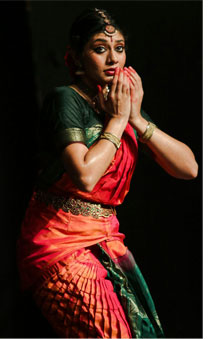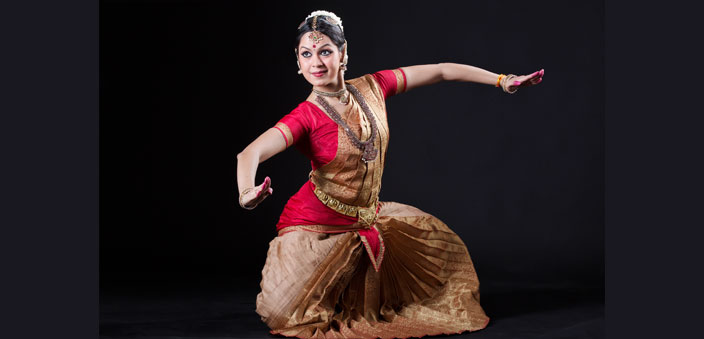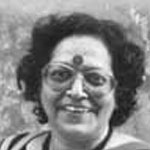More than a 100 years ago, Tagore had written several poems raising questions around the unethical representations of some characters in the great epics the Mahabharata and Ramayana.These were in the form of long poems. The more famous ones are Kabyer Upekshita (Ignored by the Great Epic) that questioned why Veda Vyas ignored and marginalised Lakshmana’s wife Urmila who was left behind in Ayodhya when Rama and Sita were banished and Lakshmana accompanied them. Another poignant poem is Karna-Kunti Sambad which describes a fictitious dialogue between Karna and Kunti in which Karna persistently accuses his mother of having abandoned him to a life without a mother in favour of the Pandavas. Patra Parichaya comprises around eight to ten dancers who train in these epic characters. In March 2015, Usha R.K. presented Krishna Premi through a two-day thematic presentation at the Malleswaram Seva Sadan in Bangalore. The idea was to bring out the different shades of love for Krishna through the eyes of Satyabhama, Rukmini, Kuchela, Draupadi, Radha and Meera.
Today, in a completely changed environment where cinema has practically overwhelmed all forms of performing art, Patra Parichaya appears like a bright ray of hope at the end of a darkening tunnel that instils a fear of whether the next generation will ever know about the injustices meted out to some of these epic characters while iconising the others. “The idea is to not only tell their stories but also to do a character sketch through dance. For instance, how does Karna stand while talking, or what facial expressions does Draupadi bear while confronting Krishna after the Kauravas try to disrobe her?” says art consultant Usha R.K., who has conceptualised and directed the recent performance of two excellent dancers of Bharatanatyam in Kolkata recently.
A statue of stone and a cut nose
The characters were Soorpanakha performed by Dakshina Vaidyanathan and Ahalya performed by Anupa Lahiry. Dakshina is the disciple of Gurus Saroja Vaidyanathan and Rama Vaidyanathan, and is a third-generation Bharat Natyam dancer. Anupa Lahiry is the disciple of Guru Chitra Visweswaran. The two have been working through these two characters under the guidance and supervision of Usha for months together, and performing on different platforms across the country.
Enacting characters through dance was not easy. Take the character of Ahalya, the wife of sage Gautama Maharishi who was believed to have been seduced by Indra, king of the gods. She was cursed by her husband for infidelity, and finally liberated from the curse by Ram. New Delhi-based dancer Arupa Lahiry, performed this character. She explained, “Ahalya was a very strong-minded woman who knew what she was doing. The dance tells of her beauty, strong will and her emotions when she was being turned into a stone as per the curse.” Usha was inspired to conceive this piece on Ahalya from a Tagore poem.

Most of us are not aware that Ahalya was blessed, a brahma gyani – who knew exactly what shape her life was going to take; she knew that this handsome man was not her husband Rishi Gautama but was Lord Indra himself. She hesitated and pondered and thought for a long while whether she should allow him the liberty of taking her and finally, surrendered, also knowing fully what will happen to her when her husband came back after his bath in the river. Cohabiting with Indra therefore was her choice, not a compulsion or a twist of fate. The interpretation is that Ahalya froze and became stone-like when her husband came back and simply closed and shut herself to the world around her. She looked within and waited for the mukti only Rama would give her.
Dakshina’s performance was not a simple retelling of the Ramayana; her version of Soorpanakha depicts the many shades of the woman — the breach of trust by her brother, Ravana, who had her husband Dushtabuddhi killed because Ravana felt the former was stronger than he was, the emptiness she feels after her husband’s death, and the strong desire for revenge. “However, according to me, she had no physical interest in Ram whatsoever, as is usually interpreted from the epic,” says Vaidyanathan. The transformation of Meenakshi (a girl with eyes like a fish) who played along with her dear brother Ravana as a child and grew up to have a very happy life with her husband to Soorpanakha, the woman with sharp nails was essayed by Dakshina with a beautiful blend of nritta and nritya in Bharatnatyam classic style. The enactment points out that Soorpanakha’s provocation of Rama to attack and hurt her was her manipulation to know whether Rama had the power and the strength to defeat Ravana or not.
These two performances stood out as voices of ethical enquiry into the treatment and portrayal of some women characters in the Ramayana and Mahabharata. Two among the many are Soorpanakha and Ahalya. The performances by the two young dancers, Dakshina and Arupa demonstrate how deeply these two young women have imbibed the characters in their changed perspectives in order to encapsulate these changes through their dance performance that is as mesmerising as it is an illustration of grace, femininity, expertise and commitment.
“Over the years since our inception, we have brought forth many characters that the epics either projected negatively or marginalised or oppressed. All this has been realised through different classical dance forms including Kathak and Kuchipudi,” Usha, the brain behind the concept said, “This is a brilliant platform for these youngsters to get recognised. Youngsters these days rarely delve into the details as they tend to make a fleeting glance of it. But here, the junior performers had to do their share of research from the puranas to understand the essence of the character and portray all the details with utmost efficiency. It is nothing but re-living of the ancient format,” she added.


 [/column]
[/column]